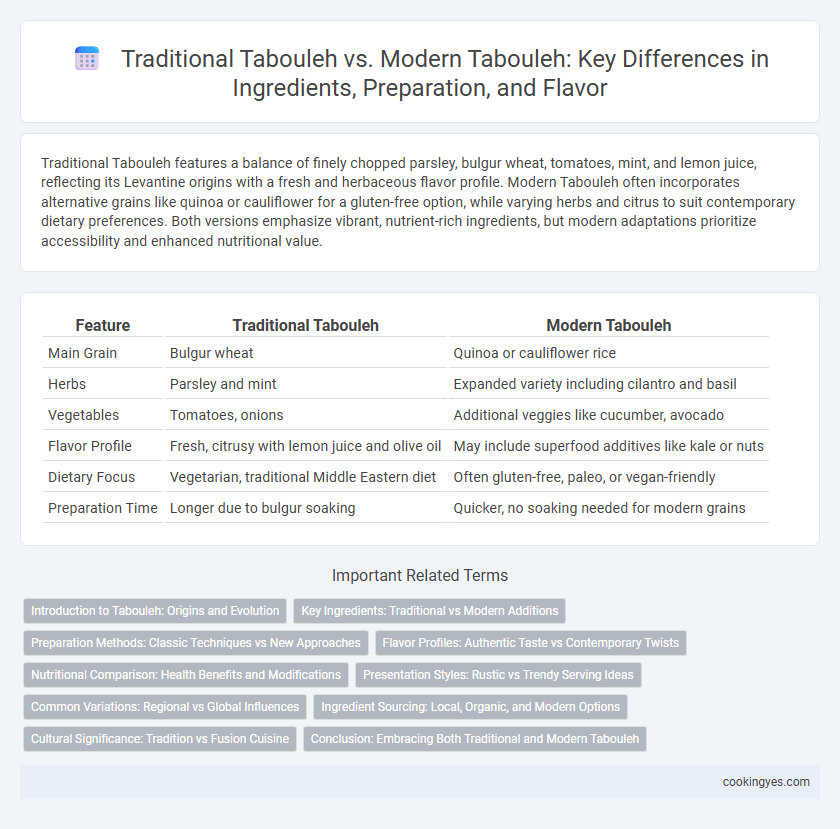Traditional Tabouleh features a balance of finely chopped parsley, bulgur wheat, tomatoes, mint, and lemon juice, reflecting its Levantine origins with a fresh and herbaceous flavor profile. Modern Tabouleh often incorporates alternative grains like quinoa or cauliflower for a gluten-free option, while varying herbs and citrus to suit contemporary dietary preferences. Both versions emphasize vibrant, nutrient-rich ingredients, but modern adaptations prioritize accessibility and enhanced nutritional value.
Table of Comparison
| Feature | Traditional Tabouleh | Modern Tabouleh |
|---|---|---|
| Main Grain | Bulgur wheat | Quinoa or cauliflower rice |
| Herbs | Parsley and mint | Expanded variety including cilantro and basil |
| Vegetables | Tomatoes, onions | Additional veggies like cucumber, avocado |
| Flavor Profile | Fresh, citrusy with lemon juice and olive oil | May include superfood additives like kale or nuts |
| Dietary Focus | Vegetarian, traditional Middle Eastern diet | Often gluten-free, paleo, or vegan-friendly |
| Preparation Time | Longer due to bulgur soaking | Quicker, no soaking needed for modern grains |
Introduction to Tabouleh: Origins and Evolution
Tabouleh, a traditional Levantine salad, originated in the mountainous regions of Lebanon and Syria, primarily composed of fine bulgur, fresh parsley, mint, tomatoes, and lemon juice. Modern tabouleh variations often replace bulgur with quinoa or couscous, catering to gluten-free diets and contemporary culinary trends. The evolution from the classic recipe reflects adaptations driven by global ingredient availability and changing nutritional preferences.
Key Ingredients: Traditional vs Modern Additions
Traditional tabouleh centers on bulgur wheat, fresh parsley, mint, tomatoes, onions, lemon juice, and olive oil, emphasizing fresh, simple, and wholesome ingredients. Modern tabouleh variations often replace bulgur with quinoa or couscous for gluten-free or different texture options and incorporate ingredients like avocado, pomegranate seeds, or kale for added flavor and nutritional benefits. The contrast between traditional and modern versions reflects evolving culinary trends blending classic Levantine flavors with contemporary superfoods and dietary preferences.
Preparation Methods: Classic Techniques vs New Approaches
Traditional Tabouleh preparation involves soaking fine bulgur in fresh lemon juice and olive oil, combined with finely chopped parsley, mint, tomatoes, and onions, emphasizing the balance of citrus and herb flavors. Modern Tabouleh variations often replace bulgur with quinoa or couscous for gluten-free alternatives and incorporate additional ingredients like avocado or kale, adapting to contemporary dietary trends. Both methods prioritize fresh, vibrant ingredients but differ in grain choices and the inclusion of novel superfoods to enhance texture and nutritional value.
Flavor Profiles: Authentic Taste vs Contemporary Twists
Traditional Tabouleh features a refreshing blend of parsley, mint, bulgur wheat, tomatoes, and lemon juice, creating a vibrant, herbaceous flavor profile rooted in Levantine cuisine. Modern Tabouleh experiments with unconventional ingredients like quinoa or kale and incorporates creative dressings, offering bolder and sometimes spicier variations while maintaining the dish's bright and fresh essence. The authentic taste emphasizes balance and simplicity, whereas contemporary twists highlight innovation and diverse flavor combinations.
Nutritional Comparison: Health Benefits and Modifications
Traditional tabouleh features bulgur wheat, parsley, tomatoes, mint, and lemon juice, providing a fiber-rich, antioxidant-packed salad with vitamins A and C, essential for immune support. Modern tabouleh variations often replace bulgur with quinoa or cauliflower for gluten-free options, enhancing protein and reducing carbohydrate content while maintaining high micronutrient density. These modifications offer tailored health benefits such as improved digestion, lower glycemic impact, and increased plant-based protein intake.
Presentation Styles: Rustic vs Trendy Serving Ideas
Traditional Tabouleh is often presented in a rustic style, served in simple bowls or earthenware that highlight its authentic Middle Eastern roots and emphasize fresh parsley, bulgur, tomatoes, and mint. Modern Tabouleh embraces trendy serving ideas, incorporating vibrant plating techniques, use of colorful glassware, edible flowers, or individual servings in mason jars to appeal to contemporary aesthetics. These presentation styles reflect the dish's evolution from a humble, family-style salad to a chic, Instagram-worthy appetizer.
Common Variations: Regional vs Global Influences
Traditional Tabouleh typically features a high ratio of fresh parsley and bulgur wheat in Middle Eastern recipes, emphasizing regional ingredients like mint, tomatoes, and lemon juice for a vibrant, herbaceous flavor. Modern Tabouleh adapts this classic by incorporating global influences such as quinoa instead of bulgur, additional vegetables like cucumbers or bell peppers, and alternative dressings that reflect diverse culinary trends. These variations highlight the dish's versatility, balancing its traditional Levantine roots with contemporary, health-conscious preferences worldwide.
Ingredient Sourcing: Local, Organic, and Modern Options
Traditional tabouleh relies on locally sourced parsley, bulgur wheat, fresh mint, and ripe tomatoes, emphasizing organic and seasonal ingredients from Mediterranean regions. Modern tabouleh often incorporates alternative grains such as quinoa or cauliflower rice, alongside organic produce sourced through local farmers' markets or specialty organic suppliers. This shift in ingredient sourcing reflects evolving dietary preferences and increased accessibility to diverse, health-conscious options.
Cultural Significance: Tradition vs Fusion Cuisine
Traditional Tabouleh, rooted in Levantine culture, emphasizes fresh parsley, bulgur, mint, tomatoes, and a simple lemon-olive oil dressing, symbolizing cultural heritage and communal dining. Modern Tabouleh variants incorporate diverse ingredients like quinoa, kale, or avocado, reflecting fusion cuisine trends and global culinary influences. The cultural significance shifts from preserving ancestral recipes to embracing innovation and cross-cultural experimentation.
Conclusion: Embracing Both Traditional and Modern Tabouleh
Traditional tabouleh, characterized by its finely chopped parsley, bulgur wheat, fresh tomatoes, mint, and lemon juice, offers an authentic and herbaceous flavor that honors its Middle Eastern origins. Modern tabouleh variations often incorporate alternative grains like quinoa or adjust ingredient ratios to suit contemporary dietary preferences without compromising the dish's refreshing qualities. Embracing both traditional and modern tabouleh celebrates culinary heritage while allowing flexibility for nutritional innovation and diverse taste preferences.
Traditional Tabouleh vs Modern Tabouleh Infographic

 cookingyes.com
cookingyes.com